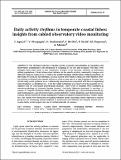Por favor, use este identificador para citar o enlazar a este item:
http://hdl.handle.net/10261/89023COMPARTIR / EXPORTAR:
 SHARE SHARE
 CORE
BASE CORE
BASE
|
|
| Visualizar otros formatos: MARC | Dublin Core | RDF | ORE | MODS | METS | DIDL | DATACITE | |

| Título: | Daily activity rhythms in temperate coastal fishes: insights from cabled observatory video monitoring |
Autor: | Aguzzi, Jacopo CSIC ORCID ; Sbragaglia, Valerio CSIC ORCID ; Santamaría, G.; Río, Joaquín del CSIC; Sardà, Francisco CSIC ORCID; Nogueras, Marc; Mànuel-Làzaro, Antoni CSIC ORCID | Palabras clave: | Daily Activities Irradiance Temperate fishes Coastal areas Western Mediterranean Swimming rhythms Cabled video observatories OBSEA |
Fecha de publicación: | jul-2013 | Editor: | Inter Research | Citación: | Marine Ecology Progress Series 486: 223-236 (2013) | Resumen: | The rhythmic behavior of marine species generates uncertainties in population and biodiversity assessments if the frequency of sampling is too low and irregular over time. Few attempts have been made to link community changes to the rhythmic behavior of individuals within populations. Cabled video observatories can be used to explore community changes over different temporal windows as a result of the activity rhythms of individuals within populations. In this study, we used, for the first time, a coastal cabled observatory (OBSEA) to video monitor activity rhythms of different fish species within an artificial reef area at a high frequency. During 1 mo, 30 min daily count patterns were continuously measured and compared with the corresponding solar irradiance. A significant (p < 0.05) day-night patterning was observed in the majority of recognized taxa by Chi-Square periodogram analysis. Three types of rhythms were identified in waveform plotting: (1) diurnal (Chromis chromis, Coris julis, Diplodus annularis, D. cervinus, D. sargus, D. vulgaris, Serranus cabrilla, Dentex dentex, Symphodus sp.); (2) nocturnal (Atherina sp. and Scorpaena sp.); and (3) crepuscular (Apogon imberbis, Oblada melanura, and Spicara maena). Diurnal species clustered around maximum averaged irradiance (computed from a cosinor analysis). The results were discussed evaluating whether visual count time series represent a reliable proxy for the swimming activity rhythms of individuals and whether the complex habitat use of coastal fishes would require the use of spatial networks of cameras | Descripción: | 14 pages, 4 figures, 1 table | Versión del editor: | https://doi.org/10.3354/meps10399 | URI: | http://hdl.handle.net/10261/89023 | DOI: | 10.3354/meps10399 | Identificadores: | doi: 10.3354/meps10399 issn: 0171-8630 e-issn: 1616-1599 |
| Aparece en las colecciones: | (ICM) Artículos |
Ficheros en este ítem:
| Fichero | Descripción | Tamaño | Formato | |
|---|---|---|---|---|
| Aguzzi_et_al_2013.pdf | 1,02 MB | Adobe PDF |  Visualizar/Abrir |
CORE Recommender
SCOPUSTM
Citations
32
checked on 01-may-2024
WEB OF SCIENCETM
Citations
30
checked on 23-feb-2024
Page view(s)
315
checked on 06-may-2024
Download(s)
213
checked on 06-may-2024
Google ScholarTM
Check
Altmetric
Altmetric
NOTA: Los ítems de Digital.CSIC están protegidos por copyright, con todos los derechos reservados, a menos que se indique lo contrario.
